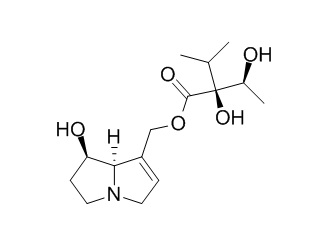Lycopsamine
Reference standards.
Inquire / Order:
manager@chemfaces.com
Technical Inquiries:
service@chemfaces.com
Tel:
+86-27-84237783
Fax:
+86-27-84254680
Address:
1 Building, No. 83, CheCheng Rd., Wuhan Economic and Technological Development Zone, Wuhan, Hubei 430056, PRC
Providing storage is as stated on the product vial and the vial is kept tightly sealed, the product can be stored for up to
24 months(2-8C).
Wherever possible, you should prepare and use solutions on the same day. However, if you need to make up stock solutions in advance, we recommend that you store the solution as aliquots in tightly sealed vials at -20C. Generally, these will be useable for up to two weeks. Before use, and prior to opening the vial we recommend that you allow your product to equilibrate to room temperature for at least 1 hour.
Need more advice on solubility, usage and handling? Please email to: service@chemfaces.com
The packaging of the product may have turned upside down during transportation, resulting in the natural compounds adhering to the neck or cap of the vial. take the vial out of its packaging and gently shake to let the compounds fall to the bottom of the vial. for liquid products, centrifuge at 200-500 RPM to gather the liquid at the bottom of the vial. try to avoid loss or contamination during handling.
Cell Death Discov.2023, 9(1):350.
Analytical Letters.2020, doi 10.1008
Pharm Biol.2021, 59(1):134-145.
Front Pharmacol.2022, 13:972825.
Int J Food Sci Nutr.2019, 70(7):825-833
J Chem Inf Model.2021, 61(11):5708-5718.
Food Quality and Safety2018, 2:213-219
Korean J. Medicinal Crop Sci.2021, 29(6):425-433
Korean Journal of Pharmacognosy2017, 48(4):320-328
Sci Rep. 2017, 12953(7)
Related and Featured Products
Acta Pharm. 2014 Dec;64(4):503-8.
TLC densitometric method for screening of lycopsamine in comfrey root (Symphytum officinale L.) extracts using retrorsine as a reference compound.[Pubmed:
25531790]
Due to severe toxicity of pyrrolizidine alkaloids, their quantification in medicinal products is very important. The idea of this research was to use retrorsine as a surrogate reference compound instead of Lycopsamine reference or Lycopsamine isolated from comfrey.
METHODS AND RESULTS:
A method for the analysis of Lycopsamine in extracts of comfrey roots was developed and validated, employing thin layer chromatography, derivatisation with Dann-Mattocks reagent followed by densitometric analysis. The new method showed linearity within 0.70 to 7.0 μg of Lycopsamine per application of 10 μL of a solution. It has also been proven to be specific and precise (repeatability RSD 2-4 % within the plate).
CONCLUSIONS:
The method was successfully employed for quantification of Lycopsamine in comfrey root and comfrey root medicinal products such as ointments.
J Appl Toxicol. 2016 May;36(5):716-25.
The comparative toxicity of a reduced, crude comfrey (Symphytum officinale) alkaloid extract and the pure, comfrey-derived pyrrolizidine alkaloids, lycopsamine and intermedine in chicks (Gallus gallus domesticus).[Pubmed:
26177929]
Comfrey (Symphytum officinale), a commonly used herb, contains dehydropyrrolizidine alkaloids that, as a group of bioactive metabolites, are potentially hepatotoxic, pneumotoxic, genotoxic and carcinogenic. Consequently, regulatory agencies and international health organizations have recommended comfrey be used for external use only. However, in many locations comfrey continues to be ingested as a tisane or as a leafy vegetable.
METHODS AND RESULTS:
The objective of this work was to compare the toxicity of a crude, reduced comfrey alkaloid extract to purified Lycopsamine and intermedine that are major constituents of S. officinale. Male, California White chicks were orally exposed to daily doses of 0.04, 0.13, 0.26, 0.52 and 1.04 mmol Lycopsamine, intermedine or reduced comfrey extract per kg bodyweight (BW) for 10 days. After another 7 days chicks were euthanized. Based on clinical signs of poisoning, serum biochemistry, and histopathological analysis the reduced comfrey extract was more toxic than Lycopsamine and intermedine.
CONCLUSIONS:
This work suggests a greater than additive effect of the individual alkaloids and/or a more potent toxicity of the acetylated derivatives in the reduced comfrey extract. It also suggests that safety recommendations based on purified compounds may underestimate the potential toxicity of comfrey.
Phytochem Anal. 2014 Sep-Oct;25(5):429-38.
Semi-automated separation of the epimeric dehydropyrrolizidine alkaloids lycopsamine and intermedine: preparation of their N-oxides and NMR comparison with diastereoisomeric rinderine and echinatine.[Pubmed:
24816769]
To investigate methods for the separation of gram-scale quantities of the epimeric dehydropyrrolizidine alkaloids Lycopsamine and intermedine and to compare their NMR spectroscopic data with those of their heliotridine-based analogues echinatine and rinderine.
METHODS AND RESULTS:
Lycopsamine and intermedine were extracted, predominantly as their N-oxides and along with their acetylated derivatives.Examination of the NMR data for Lycopsamine, intermedine and their heliotridine-based analogues echinatine and rinderine allowed for some amendments of literature data and provided useful comparisons for determining relative configurations in monoester dehydropyrrolizidine alkaloids. A similar NMR comparison of Lycopsamine and intermedine with their N-oxides showed the effects of N-oxidation on some key chemical shifts. A levorotatory shift in specific rotation from +3.29° to -1.5° was observed for Lycopsamine when dissolved in ethanol or methanol respectively.
CONCLUSIONS:
A semi-automated flash chromatographic process using boronated soda glass beads was standardised and confirmed as a useful, larger scale preparative approach for separating the epimers Lycopsamine and intermedine.



